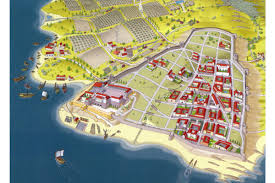
Algeciras en la antigüedad
Los primeros testimonios de la presencia humana en la Bahía datan de hace unos 300.000 años, con comunidades de cazadores recolectores que se asentaron sobre las terrazas de los ríos y terrazas costeras que se extienden desde Torre Almirante hasta el Faro de Punta Carnero.
Las manifestaciones abarcan una cronología desde el Paleolítico Superior hasta épocas protohistóricas con la transformación en sociedades ganaderas y agricultoras desde finales del Neolítico-Calcolítico y Bronce. La comarca tiene el foco de arte rupestre paleolítico en cavidades poco profundas más numeroso del territorio andaluz.
A mediados del Siglo VII a.C. se ubica una factoría fenicia en la Bahía que evoluciona a una ciudad púnica portuaria y que en época romana llega a ser la primera colonia de carácter látino en la Península: Carteia. El actual yacimiento se encuentra en el municipio vecino de San Roque.


Algeciras in Ancient Times 
The oldest things confirming a human presence in the Algeciras Bay area date back to 300,000 years ago, and stretch from the Admiral Tower to the Ram's Point Lighthouse.
These findings cover Algeciras' history beginning in the Paleolithic period and continuing through the Protohistoric Era with the changing of society into a hunter-gatherer one until the end of the Neolithic and Bronze Ages. This region has the most cave wall art from the Paleolithic period in all of Andalusia.
In the mid-seventh century B.C., the Phoenicians settled in the Bay and created a port city here, which in the Roman period became the first Latin colony in the entire Iberian Peninsula: Carteia. The actual archeological remains can be found in the neighboring city of San Roque.



